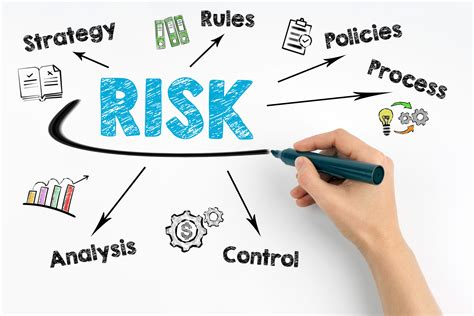Managing Business Risks in Uncertain Times

Learn how to understand, identify, assess, implement, and adapt to business risks and market changes with our comprehensive guide. Reach your business goals with confidence.In today’s rapidly changing business landscape, managing risks has become essential for the survival and success of any organization. With uncertainties looming over the global economy, it’s crucial for businesses to stay ahead of potential threats and adapt to changing market conditions. This blog post will delve into the key components of managing business risks in uncertain times, from understanding the various types of risks that can impact operations to identifying potential threats that could arise. We will also explore the importance of assessing the impact of these risks on day-to-day business activities and the implementation of effective risk mitigation strategies. Additionally, we will discuss the significance of adapting to changing market conditions and how businesses can proactively navigate through uncertain times to ensure their long-term sustainability and growth. Whether you’re a small startup or a large corporation, understanding and effectively managing business risks is vital for staying competitive in today’s volatile business environment.
Understanding Business Risks
Understanding business risks is a crucial aspect of running a successful company. Risks can come in various forms, such as financial, operational, and strategic. It is essential for business owners and managers to identify and assess these risks to protect their company from potential threats and navigate the ever-changing business landscape.
One of the first steps in understanding business risks is to conduct a comprehensive risk assessment. This involves analyzing the potential impact of various internal and external factors on the company’s operations. By identifying potential threats early on, businesses can proactively prepare and implement strategies to mitigate these risks.
As businesses continue to operate in uncertain times, it is important to stay agile and adaptable. Adapting to changing market conditions is a key component of managing business risks. By understanding the dynamics of the market and being open to change, businesses can stay ahead of potential threats and ensure the long-term success of their operations.
Identifying Potential Threats
Identifying potential threats to your business is an important step in managing business risks in uncertain times. In today’s rapidly changing market conditions, it’s crucial to stay vigilant and proactive in identifying any potential threats to your operations. This could range from cybersecurity risks to supply chain disruptions, and everything in between. By staying aware of the potential threats, you can better assess their impact on your business and implement necessary risk mitigation strategies.
One way to identify potential threats is to conduct a thorough risk assessment of your current operations. This involves analyzing your business processes, systems, and external factors that could pose a threat to your business. By conducting a comprehensive risk assessment, you can uncover any vulnerabilities and potential risks that may exist within your business.
Furthermore, staying informed and keeping abreast of industry trends and market developments can help you identify potential threats in advance. By understanding the changing market conditions and potential disruptions, you can adapt your business strategies and operations to mitigate the impact of these threats. It’s essential to have a proactive approach to identifying potential threats, as this can help you stay ahead of potential risks and ensure the longevity of your business.
Assessing Impact on Operations
When it comes to managing business risks in uncertain times, one of the critical steps is assessing the impact on operations. This involves carefully analyzing the potential risks and their direct effects on the day-to-day functioning of the business. For example, if a major supplier experiences a disruption in production, it could lead to delays in receiving essential materials, impacting the production schedule and ultimately, the ability to meet customer demands.
Furthermore, assessing the impact on operations also involves evaluating the financial implications of potential risks. A sudden increase in the cost of raw materials, for instance, could significantly impact the company’s bottom line and cash flow. It’s important to take a holistic approach and consider how these operational impacts can cascade throughout the entire organization.
In order to effectively assess the impact on operations, businesses need to have a comprehensive understanding of their internal processes and dependencies. This includes identifying critical functions, key personnel, and essential resources. By conducting a thorough assessment, businesses can proactively identify vulnerabilities and develop contingency plans to minimize the impact of potential risks.
Implementing Risk Mitigation Strategies
Implementing risk mitigation strategies is crucial for businesses, especially in uncertain times. With the ever-changing market conditions and potential threats looming, it is vital for organizations to have a solid plan in place to address and minimize risks. One of the key steps in implementing risk mitigation strategies is to conduct a thorough assessment of potential threats and their impact on operations. This involves identifying all possible risks that could affect the business, ranging from economic downturns to natural disasters, and evaluating how each of these risks could disrupt the normal functioning of the company.
Once the potential threats are identified, the next step is to prioritize them based on their severity and likelihood of occurrence. Risk assessment tools can help businesses quantify and prioritize risks, allowing them to allocate resources effectively to address the most critical threats. This enables organizations to focus their efforts and resources on mitigating the risks that pose the greatest impact on their operations and overall business objectives.
After prioritizing the risks, the final step is to develop and implement risk mitigation strategies that are tailored to address each specific threat. This may involve a combination of measures such as investing in insurance coverage, diversifying business operations, creating redundancy in critical systems, or establishing contingency plans for potential disruptions. By proactively implementing these strategies, businesses can minimize the impact of potential risks and increase their resilience in the face of uncertainty.
Adapting to Changing Market Conditions
In today’s rapidly evolving business landscape, adapting to changing market conditions has become an essential skill for any successful company. With the rise of globalization, technological advancements, and economic uncertainty, the business environment is more unpredictable than ever. Companies need to be proactive in identifying and analyzing market trends to stay ahead of the competition.
One of the key strategies for adapting to changing market conditions is to establish a strong network of industry contacts and stay informed about developments in the market. By building relationships with suppliers, customers, and industry experts, businesses can gain valuable insight into emerging trends and potential challenges. This proactive approach allows companies to anticipate changes and make informed decisions to mitigate risks.
Additionally, businesses can adapt to changing market conditions by diversifying their product offerings, expanding into new markets, and embracing innovation. By continuously evaluating their business model and exploring new opportunities, companies can position themselves to thrive in any economic climate. Flexibility and agility are key attributes for businesses looking to succeed in the face of uncertainty.





